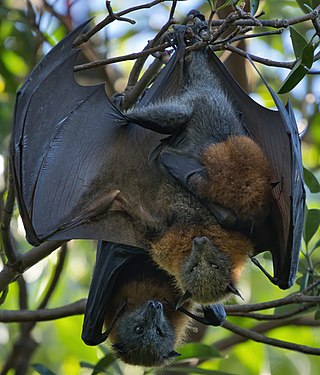| Pteropodinae | |
|---|---|
 | |
| Pteropus poliocephalus with baby | |
| Scientific classification | |
| Kingdom: | Animalia |
| Phylum: | Chordata |
| Class: | Mammalia |
| Order: | Chiroptera |
| Family: | Pteropodidae |
| Subfamily: | Pteropodinae (Gray, 1821) |
| Genera | |
Acerodon | |
The Pteropodinae are a subfamily of megabats. Taxa within this subfamily are:
- Genus Acerodon
- Sulawesi flying fox, A. celebensis
- Talaud flying fox, A. humilis
- Giant golden-crowned flying fox, A. jubatus
- Palawan fruit bat, A. leucotis
- Sunda flying fox, A. mackloti
- Genus Desmalopex
- White-winged flying fox, D. leucopterus
- Small white-winged flying fox, D. microleucopterus
- Genus Eidolon — straw-coloured fruit bats
- Madagascan fruit bat, E. dupreanum
- Straw-coloured fruit bat, E. helvum
- Genus Mirimiri
- Fijian monkey-faced bat, M. acrodonta
- Genus Neopteryx
- Small-toothed fruit bat, N. frosti
- Genus Pteralopex - flying monkeys
- Bougainville monkey-faced bat, P. anceps
- Guadalcanal monkey-faced bat, P. atrata
- Greater monkey-faced bat, P. flanneryi
- Montane monkey-faced bat, P. pulchra
- New Georgian monkey-faced bat, P. taki
- Genus Pteropus — flying foxes
- P. alecto species group
- Black flying fox, P. alecto
- P. caniceps species group
- Ashy-headed flying fox, P. caniceps
- P. chrysoproctus species group
- Silvery flying fox, P. argentatus
- Moluccan flying fox, P. chrysoproctus
- Makira flying fox, P. cognatus
- Banks flying fox, P. fundatus
- Solomons flying fox, P. rayneri
- Rennell flying fox, P. rennelli
- P. conspicillatus species group
- Spectacled flying fox, P. conspicillatus
- Ceram fruit bat, P. ocularis
- P. livingstonii species group
- Aru flying fox, P. aruensis
- Kei flying fox, P. keyensis
- Livingstone's fruit bat, P. livingstonii
- Black-bearded flying fox, P. melanopogon
- P. mariannus species group
- Okinawa flying fox, P. loochoensis
- Mariana fruit bat, P. mariannus
- Pelew flying fox, P. pelewensis
- Kosrae flying fox, P. ualanus
- Yap flying fox, P. yapensis
- P. melanotus species group
- Black-eared flying fox, P. melanotus
- P. molossinus species group
- Lombok flying fox, P. lombocensis
- Caroline flying fox, P. molossinus
- Rodrigues flying fox, P. rodricensis
- P. neohibernicus species group
- Great flying fox, P. neohibernicus
- P. niger species group
- Aldabra flying fox, P. aldabrensis
- Mauritian flying fox, P. niger
- Madagascan flying fox, P. rufus
- Seychelles fruit bat, P. seychellensis
- Pemba flying fox, P. voeltzkowi
- P. personatus species group
- Bismark masked flying fox, P. capistratus
- Masked flying fox, Pteropus personatus
- Temminck's flying fox, P. temminckii
- P. poliocephalus species group
- Big-eared flying fox, P. macrotis
- Geelvink Bay flying fox, P. pohlei
- Grey-headed flying fox, P. poliocephalus
- P. pselaphon species group
- Chuuk flying fox, P. insularis
- Temotu flying fox, P. nitendiensis
- Large Palau flying fox, P. pilosus (19th century †)
- Bonin flying fox, P. pselaphon
- Guam flying fox, P. tokudae (1970s †)
- Insular flying fox, P. tonganus
- Vanikoro flying fox, P. tuberculatus
- New Caledonia flying fox, P. vetulus
- P. samoensis species group
- Vanuatu flying fox, P. anetianus
- Samoa flying fox, P. samoensis
- P. scapulatus species group
- Gilliard's flying fox, P. gilliardorum
- Lesser flying fox, P. mahaganus
- Little red flying fox, P. scapulatus
- Dwarf flying fox, P. woodfordi
- P. subniger species group
- Admiralty flying fox, P. admiralitatum
- Dusky flying fox, P. brunneus (19th century †)
- Ryukyu flying fox, P. dasymallus
- Nicobar flying fox, P. faunulus
- Gray flying fox, P. griseus
- Ontong Java flying fox, P. howensis
- Small flying fox, P. hypomelanus
- Ornate flying fox, P. ornatus
- Little golden-mantled flying fox, P. pumilus
- Philippine gray flying fox, P. speciosus
- Small Mauritian flying fox, P. subniger (19th century †)
- P. vampyrus species group
- Indian flying fox, P. giganteus
- Andersen's flying fox, P. intermedius
- Lyle's flying fox, P. lylei
- Large flying fox, P. vampyrus
- incertae sedis
- Small Samoan flying fox, P. allenorum (19th century †)
- Large Samoan flying fox, P. coxi (19th century †)
- P. alecto species group
- Genus Styloctenium
- Mindoro stripe-faced fruit bat, S. mindorensis
- Sulawesi stripe-faced fruit bat, S. wallacei
- Genus Melonycteris
- Fardoulis's blossom bat, Melonycteris fardoulisi
- Black-bellied fruit bat, Melonycteris melanops
- Woodford's fruit bat, Melonycteris woodfordi













